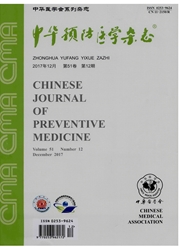

 中文摘要:
中文摘要:
目的探讨S-腺苷L-蛋氨酸(S-adenosyl—L—methionine,SAM)对发育期慢性铅暴露大鼠血铅浓度、肝脏、脑、海马组织氧化损伤的影响,及其对铅暴露引起的长时程增强(long—term potentiation,LTP)和双脉冲易化(paired-pulse facilitation,PPF)的损伤的修复作用。方法采用抽签法将受孕Wistar大鼠按每组3只随机分为3组:对照组,全程饮用自来水,仔鼠断乳后每天腹腔注射生理盐水;染铅组,孕期与哺乳期染铅,仔鼠断乳后每天腹腔注射生理盐水;铅+SAM注射组,孕期与哺乳期染铅,仔鼠断乳后每天腹腔注射20mg/kg的SAM,22d后测定各组仔鼠血铅浓度和肝脏、脑、海马组织氧化指标,并在位记录各组大鼠海马齿状回PPF和LTP。结果对照组、染铅组和铅+SAM组血铅浓度分别为(27.5±3.8)、(159.3±10.9)、(33.1±9.5)μg/L,铅+SAM组与染铅组比较差异有统计学意义(F=213.5,P〈0.01);SAM能提高染铅组肝脏、脑组织的谷胱苷肽(GSH)水平、降低丙二醛(MDA)水平,与染铅组比较差异均有统计学意义(P〈0.05);与对照组兴奋性突触后电位(field excitatory postsynaptic potential,EPSP)LTP幅度[(131±4.5)%]相比,染铅组LTP[(112±2.1)%]明显下降,而铅+SAM组能修复LTP至(120±2.6)%,差异有统计学意义(F=26.1,P〈0.05)。结论SAM对临床上慢性铅中毒儿童尤其是学习记忆损伤的修复可能具有一定作用。
 英文摘要:
英文摘要:
Objective To explore the effects of S-adenesyl-L-methionine (SAM) on blood lead concentration and oxidative stress of tissue in prenatal and postnatal lead-exposed rats, and evaluate the potential reparation exerted by SAM on paired-pulse facilitation(PPF) and long-term potentiation (LTP) in lead-expoeed rat. Methods Pregrumt Wister rats were randomly divided into three groups: control, lead-exposed and leadexposed with SAM treatment groups, l.e.ad-exposed rats drank 1.5 g/L lead acetate solution through pregnancy until weaning and then the pups received 20 mg/kg SAM or saline daily intraperitoneaUy depending on their group. Control group rats drank tap water throughout the experiment. At the postnatal 44 -60 days, all the pup rats were given an extracellular recording measured in dentate gyrus (DG) area of hippocampus. The blood lead concentration and oxidative stress in liver, brain and hippoeampus were also detected. Results The blood lead concentration in lead-exposed group was higher ( 159. 3 ± 10. 9 μg/L) in comparing with those of control group (27.5 ±3.8 μg/L) and lead +SAM group (33. 1±9.5 μg/L) (F=213.5, P〈0.01). A significant recovery of liver, brain glutathion (GSH) and malondialdehyde (MDA) level was clearly produced in lead-exposed rats after SAM treatment (P 〈0. 05). Chronic lead exposure during development impaired LTP measured on field excitatory postsynaptic potential (EPSP) [ ( 112 ± 2. 1 )% ]compared with control rats[ ( 131 ± 4. 5 )% ]and the impaired LTP could be significantly increased by SAM treatment [ ( 120 ± 2. 6) % ] (F = 26. 1, P 〈 0. 05). Conclusion SAM might be beneficial for treatment of lead intoxication, especially in the rescue of learning and memory impairment induced by lead and should deserve more detailed research.
 同期刊论文项目
同期刊论文项目
 同项目期刊论文
同项目期刊论文
 Effects of Decabrominated Diphenyl Ether (PBDE 209) on Voltage-Gated Sodium Channels in Primary Cult
Effects of Decabrominated Diphenyl Ether (PBDE 209) on Voltage-Gated Sodium Channels in Primary Cult Effects of Chronic Administration of Melatonin on Spatial Learning Ability and Long-term Potentiatio
Effects of Chronic Administration of Melatonin on Spatial Learning Ability and Long-term Potentiatio Opposite effects of alpha-lipoic acid on antioxidation and long-term potentiation in control and chr
Opposite effects of alpha-lipoic acid on antioxidation and long-term potentiation in control and chr Effects of Cd2+ on transient outward and delayed rectifier potassium currents in acutely isolated ra
Effects of Cd2+ on transient outward and delayed rectifier potassium currents in acutely isolated ra Enriched environment restores impaired hippocampal long-term potentiation and water maze performance
Enriched environment restores impaired hippocampal long-term potentiation and water maze performance Unmodified CdSe Quantum Dots Induced Elevation of Cytoplasmic Calcium Levels and Impairment of Funct
Unmodified CdSe Quantum Dots Induced Elevation of Cytoplasmic Calcium Levels and Impairment of Funct Case-control study of blood lead levels and attention deficit hyperactivity disorder in Chinese chil
Case-control study of blood lead levels and attention deficit hyperactivity disorder in Chinese chil Monosialoanglioside (GM1) prevents lead-induced neurotoxicity on long-term potentiation, SOD activit
Monosialoanglioside (GM1) prevents lead-induced neurotoxicity on long-term potentiation, SOD activit Muscarinic cholinergic modulation of synaptic transmission and plasticity in rat hippocampus followi
Muscarinic cholinergic modulation of synaptic transmission and plasticity in rat hippocampus followi Epigallocatechin-3-gallate induced primary cultures of rat hippocampal neurons death linked to calci
Epigallocatechin-3-gallate induced primary cultures of rat hippocampal neurons death linked to calci Effects of Decabrominated Diphenyl Ether (PBDE 209) Exposure at Different Developmental Periods on S
Effects of Decabrominated Diphenyl Ether (PBDE 209) Exposure at Different Developmental Periods on S The different roles of cyclinD1-CDK4 in STP and mGluR-LTD during the postnatal development in mice h
The different roles of cyclinD1-CDK4 in STP and mGluR-LTD during the postnatal development in mice h Mercury-selenium association in antarctic seal hairs and animal excrements over the past 1,500 years
Mercury-selenium association in antarctic seal hairs and animal excrements over the past 1,500 years Clioquinol and vitamin B12 (cobalamin) synergistically rescue the lead-induced impairments of synapt
Clioquinol and vitamin B12 (cobalamin) synergistically rescue the lead-induced impairments of synapt JNK1 contributes to metabotropic glutamate receptor-dependent long-term depression and short-term sy
JNK1 contributes to metabotropic glutamate receptor-dependent long-term depression and short-term sy 期刊信息
期刊信息
